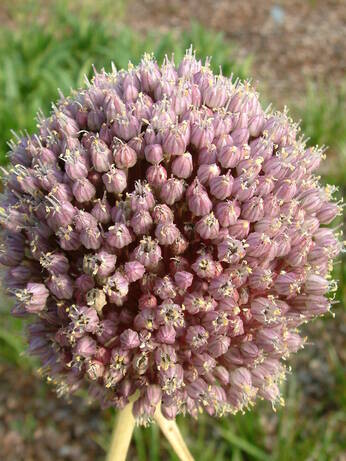Find out what the garden and propagation teams have been up to this week.

Alliums

The Gravel Garden simply wouldn’t be the same without alliums. A fabulous bulb for anyone creating their own drought-resistant garden. They are dramatic, decorative and best of all, easy to grow. They can add so much to the look of a border with their spherical heads. Just make sure you can give them a free-draining, light soil with plenty of sunshine and you will be guaranteed success.
Part of the onion family, alliums have interesting, showy heads that are made up of tens and tens of tiny individual star-like flowers. They start to open in late spring once the tulips have finished and provide bright, bold colour and structure all summer. The blooms vary hugely in size. Some are the size of a ping pong ball while others can be as large as a football.
Popular Types
We grow many alliums here, many planted in drifts throughout the Gravel and Reservoir Gardens. Here are just a few of our most popular varieties:
Allium cristophii – Huge, globular heads made up of nearly one hundred metallic, lilac-purple stars on delicate spoke-like stems.
Allium ampeloprasum – Differs from other ornamental onions in having wide, blade-like, grey-blue leaves. Tall strong stems carry in midsummer, large round buds held in pointed papery cases, like candle snuffers. These split off to release large heads of tightly packed silvery-pink flowers.
Allium hollandicum ‘Purple Sensation’ – Probably the best know allium. Standing three feet tall with rich, mauve flowers. The Chelsea Flower Show wouldn’t be the same without it.
Allium 'Purple Sensation'
Aliium karataviense – Shorter growing with two broad, curved, fleshy leaves cradling a pinky-beige flower nearly the size of a tennis ball.
Allium karataviense
Allium sphaerocephalon – Thin stalks carry wine-red and plum shaped flowers usually a little later than the other types.
Allium carinatum subsp. pulchellum- Charming and valuable in late summer, especially among silver-foliage plants when many dusty-lilac bells dangle from massed slender stems. Retains its colour when dried.
Allium carinatum subsp. pulchellum
Wildlife benefit
The flowers of all onion species are highly attractive to insects, especially bumblebees, honeybees and hoverflies. The seeds of most species have an oil-body that attracts ants: the ants take the oil-body as food, dispersing the seed in the process.
Planting
Alliums look particularly good in amongst Mediterranean plants, sucha as lavender, phlomis, artemisia and sage. However, one of our personal favourite combinations are alliums planted through clumps of the airy ornamental grass Stipa tenuissima.
When planting bulbs, common advice is to group several together to provide impact. This is true for the smaller alliums, although you will find it is not necessary with the larger flowering forms. Planting in drifts will create a more natural feel and help add another layer of depth to the border.
Alliums offer more than just their colour too. By the end of the summer, the nectar-rich flowers start to fade and dry. The strong, stiff stems can then stand proudly well into autumn. Do however, prepare yourself for the potential of many seedlings appearing the following spring.
We stock many alliums on our nursery. We pot them in the autumn so they can root over winter and be ready for sale in early spring. Read about the advantages of planting bulbs from pots in spring.








COMMENTS